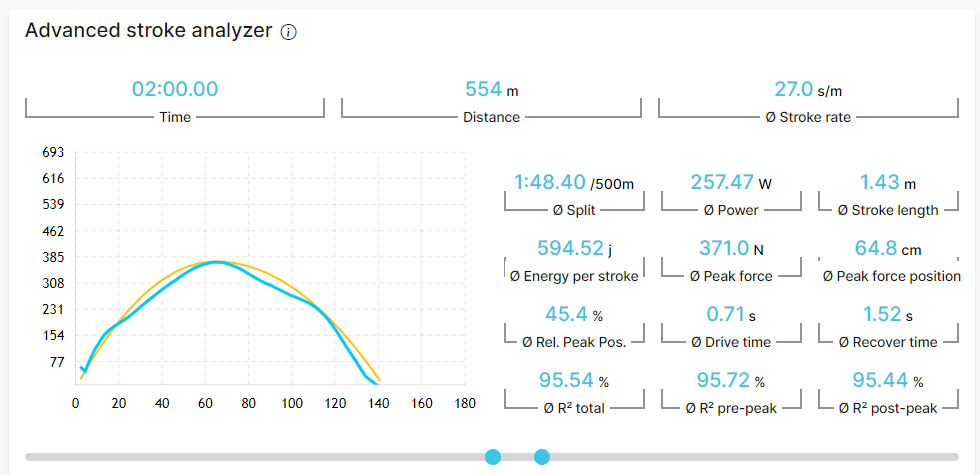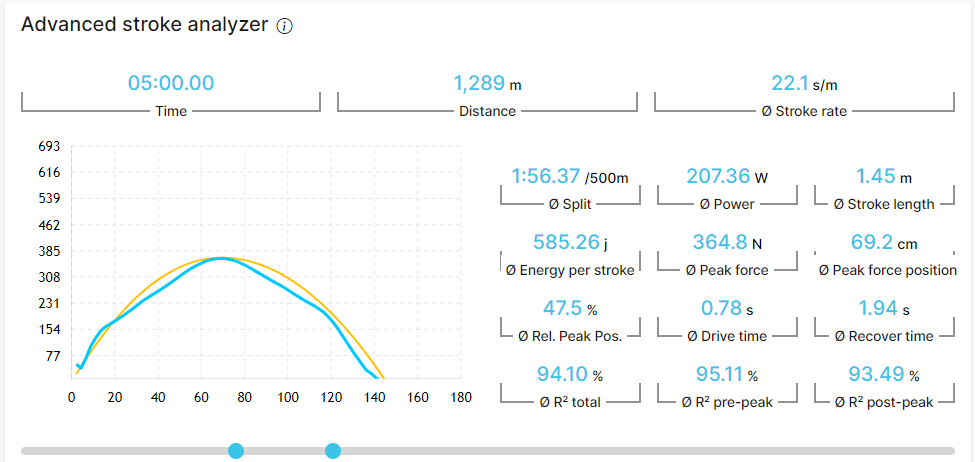Coaching with RP3 Portal
8 May 2024

Enhancing Rowing Performance with Interactive Data and Feedback
Interactive data and real-time feedback are revolutionizing the way rowers perfect their stroke on the RP3 dynamic rowing machine. By leveraging advanced sensors and analytics, the RP3 machine and app provide immediate, detailed insights into every aspect of a rower's performance.
This continuous feedback loop allows athletes to make precise adjustments to their technique, ensuring each stroke is powerful and efficient.
& Real-Time Performance Metrics: Rowers can monitor key metrics such as stroke length, drive time, energy per stroke and (rel.) peak force position times instantly, next to the shape of the Force Curve. This immediate data helps in identifying inefficiencies and making on-the-fly corrections to optimize performance.
& Technique Analysis: Detailed breakdowns of stroke mechanics, including the drive and recovery phases, enable rowers to refine their form. Interactive feedback highlights areas for improvement, such as maintaining consistent connection and drive. To ingrain in the muscle memory and take along in the boat.
& Progress Tracking: Advanced software (reporting and analysis) tracks performance over time, allowing rowers to visualize their progress and set measurable goals. This historical data is crucial for recognizing patterns and making informed adjustments to training regimens. Detailed workout analysis (qualitative values) provide technical accents for next training, on RP3 as well as in the boat.
& Personalized Coaching: RP3 dynamic rowing offers integration with coaching apps and platforms, providing personalized training plans based on the rower’s data. Coaches can remotely analyze performance and offer tailored personal advice, enhancing the learning experience.
By integrating these technological advancements, RP3 Rowing helps rowers achieve the perfect coordinated stroke, maximizing efficiency and performance on the water. Interactive data and feedback are essential tools in the modern rower’s toolkit, driving continuous improvement and excellence in the sport.
Read more on the RP3 Academy page
Shadow and Reference Mode
Every rower should aim for the perfect stroke and become able to perform this stroke always and anywhere, in all circumstances. But the perfect stroke doesn't exist, in fact it is always personal and relative to the conditions.

The perfect stroke is a haystack shaped stroke which is shaped by four factors:
- stroke length: base of the shape
- peak force: highest point of the shap
- peak force position: ideal around 46-47% of the shape (based on scientific measurements)
- convex and flowing shape
Reading the Force Curve and know about the most common improvements for failures:
- apply more force when the line (curve) remains flat
- too much force to the end, no force at the start of the drive
- too much in the first part, not being able to keep driving to the end (lost all in the catch)
- staying connected, make a smooth force curve to the end
- towards a fully connected, smoothly shaped curve
- two phased curve (loosing the connection)
The two Force Curve modes explained:
Set the required (personal) Curve Shape as a Reference mode target to train the consistent shape.
Use the "Advanced Stroke Analyzer" to see the difference / delta with the theoretical perfect curve.

With the Advanced Portal function you can select a workout range and compare the theoretical perfect average curve of that segment with the performed avg. curve and see the delta's:
- R-Square total: full curve percentage
- R-Square pre-peak: first part percentage
- R-Square post-peak: second part percentage

You can analyse the workout by comparing the "R-Square" percentages of segments of the workout.
Analyse: this examples shows the quality of the stroke improves during the workout --> going up and comming together.
Back to the Knowledge Base main page